NOAA Sea Grant Documentary Short on Coastal Storm Awareness educates Emergency Managers, empowers Coastal Communities
Video also points to resources from NOAA's National Weather Service, the Federal Emergency Management Agency, NYC Office of Emergency Management and more
VIDEO: The 4-1/2 minute trailer for NOAA Sea Grant's Coastal Storm Awareness Program's 23-minute documentary, view-able on YouTube.
AUDIO: Theme Song: "Ask Yourself," Written and performed by Barbara A. Branca
Note: If you don't see the player above, it's because you're using a non-Flash device (eg, iPhone or iPad).
Press Release Contacts:
- Barbara A. Branca, New York Sea Grant, Communications Manager, E: Barbara.Branca@stonybrook.edu, P: 631-632-6956
- Paul C. Focazio, New York Sea Grant, Web Content Manager, E: paul.focazio@stonybrook.edu, P: 631-632-6910
-
Margaret (Peg) Van Patten, Communications Director, Connecticut Sea Grant, E:
peg.vanpatten@uconn.edu, P: 860-405-9141
- Nancy Balcom, Associate Director, Connecticut Sea Grant, E: nancy.balcom@uconn.edu
- Rebecca Nagy, Communications Specialist, New Jersey Sea Grant, E: rnagy@njseagrant.org, P: 732-872-1300 x18
New York, NY, May 19, 2016 - In late October 2012, “Superstorm” Sandy traveled up the Atlantic coast and came ashore in the tri-state region. In her wake, she left 117 people dead, billions of dollars in property and business losses, and thousands of lives shattered. While evacuation orders were in place, there was still significant loss of life in flooded homes. Why didn’t or couldn’t people leave for safe shelter?
Answering this question is at the heart of the $1.8M National Oceanic and Atmospheric Administration-funded Coastal Storm Awareness Program (CSAP), a series of social science studies that Sea Grant programs in New York, New Jersey and Connecticut recently wrapped up and reflect on in a new 23-minute documentary short and accompanying four-and-a-half minute trailer.
The goal of this suite of 10 research projects - which were competitively funded at institutions from Yale University to Mississippi State University via Sandy Supplemental funds appropriated by Congress under the Disaster Relief Appropriations Act of 2013 - was to better understand how people react to storm warnings and make the decision to stay or to go.
As discussed in the short documentary, “Knowing your audience” is important to successful messaging. Yet, this can be complicated when the same message is perceived differently by groups of individuals. Based on an analysis of risk perception and other factors, Jennifer Marlon and her colleagues at Yale University grouped people into five categories.
The “First Out” are anxious and eager to leave if a hurricane is forecast, while on the other end of the spectrum the “Diehards” feel confident they are prepared to ride the storm out at home and typically will not evacuate. In the middle are the “Constrained”, the “Optimists” and the “Reluctant.”
Those who are constrained recognize the risks and are willing to leave, but face barriers such as health issues or pets that limit their options on where they can go.
Optimists doubt the storm will actually materialize or be as bad as predicted but are willing to evacuate, while the Reluctant prefer to remain at home but will leave if ordered to evacuate. One of the respondents from interviews conducted by CSAP-funded researchers Sharon Moran and William Peace from the State University of New York's College of Environmental Science and Forestry, would fall somewhere within these two categories: “We were not expecting the worst ... Hurricane Irene didn’t really do much damage at all … we were told to evacuate at our door and we chose to stay."
Each of these groups has a different reaction to storm warnings. Recognize yourself?
Message Received? How People Access News of Storm Warnings
People used a broad array of communication platforms to obtain reports and information on Sandy. Television and Internet were primary sources, but social media like Twitter and Facebook were also important, as were radio and cell phone apps. John Edwards and his team at Mississippi State University documented shifts in how people obtained information throughout storm Sandy, moving away from television and the Internet towards radio and face-to-face conversations as power outages increased. This underscores the need for official storm messages to be issued through many media platforms to ensure that before, during, and after a storm people have the means to get current, accurate, and relevant information.
No matter how people followed the progress of Sandy, the researchers identified several factors that strongly influenced the decisions people made with respect to the storm and evacuation. The factors included both the source and format of the warnings, previous experience with coastal storms, and demographics. People seem to trust different sources of storm information—they recognized the NOAA National Weather Service as the authoritative source of weather information but expected and preferred to receive its information from more local sources. Local or state officials, television news reports, and family, friends, and neighbors were all key sources of information.
The Yale study clearly indicates that if you want people to listen to evacuation orders, then have local fire fighters or police issue them, since they have the greatest likelihood of being listened to by all five population groups. Christa Farmer and her team at Hofstra University found that actions taken by local
fire departments or police, such as going door to door or evacuating their own families, can have a greater influence on residents than just the evacuation order itself. In addition, emergency managers interviewed by Cara Cuite and her colleagues at Rutgers University indicated they may use scare tactics or guilt to drive home the message that at some point during the storm, it may become too dangerous for first respondents to rescue someone who fails to evacuate as advised.
In contrast, Ricardo Daziano and his colleagues at Cornell University and Edwards both determined that family, friends, neighbors, local TV news, or The Weather Channel played major roles in influencing evacuation decisions, more so than government agencies or officials.
How Storm Warnings Are Formatted and Received By Coastal Residents
A second factor influencing evacuation decisions is the warning format. The key take-home message here is that the word “voluntary,” used in combination with evacuation orders, was determined to be completely ineffective by both Cuite and Daziano. Very few people seriously consider evacuating when it is promoted as a voluntary measure. In contrast, using the word “mandatory” with evacuation orders gets people’s attention.
“We would advise against using the word ‘voluntary’ in any evacuation messaging,” said Cuite. Daziano found that compliance was likely to be 24X greater when “mandatory evacuation” was used. He also found that the majority of those interviewed were less likely to evacuate under a voluntary evacuation order, compared to having no evacuation order in effect at all. Other format-related findings included providing precise “what-to-do” instructions linked to the community level and emphasizing practical reality such as “the shower and toilet won’t work” (from researchers Hogan Carr at Nurture Nature Center and Farmer).
Laura Hoven and her research team at Columbia University documented a shift from what people surveyed actually did during Sandy (27% ignored a mandatory evacuation order) to what they predicted doing in the future (83% would evacuate under voluntary orders and 100% under mandatory orders). Marlon found that one in five coastal residents living in Evacuation Zone A (closest to the water) and facing a Category 2 hurricane would evacuate without an official notice, whereas six in ten said they would evacuate if officially ordered.
Evacuation orders or flood warnings are rather meaningless if people don’t know where they live, relative to the scope of those orders or warnings. Some may leave their homes unnecessarily, while others who need to leave remain at home. And do people actually know where those evacuation signs lead? In 2013, New York City's Office of Emergency Management revised the City's hurricane evacuation zones and initiated a “Know Your Zone” campaign with maps to help familiarize residents with these changes. Connecticut coastal communities need something similar, given that Marlon determined that 70% of coastal Connecticut residents surveyed don’t know if they live in an evacuation zone and 74% have never seen a local evacuation map.
The terminology used in storm warnings plays an important role in determining whether the risk conveyed is understood by the general populace to whom the warning is directed. Hoven found that few people had any concept of what the term “storm surge” means; some envisioned a tsunami. NOAA's National Weather Service has recently begun to characterize storm surge as “height of the water above ground level” which will hopefully help people visualize and understand what is meant by future storm surge warnings.
Should I Stay Or Should I Go? Influencing The Decision-Making Process
A third factor, previous experience with coastal storms, also had a strong influence on how people reacted to storm warnings for Sandy. Hoven found that while the most important factor in a decision TO evacuate during Sandy was the family’s personal safety, the most important factor in a decision NOT to evacuate was previous experience.
Sharon Moran and her SUNY team also found that people who evacuated during Irene in 2011, when it turned out not to be necessary, made the decision not to evacuate for Sandy. This decision had tragic consequences for some families. No storm is ever the same as previous ones. Cliff Scherer and his team at Cornell University and Gabrielle Wong-Parodi and her team at Carnegie Mellon University both found that previous experience also hinders or colors a person’s ability to conceptualize just how bad a storm can be. People can only imagine the worst storm they have ever experienced.
“When they said it was going to be a really bad storm, I envisioned the worst I had experienced," said one of the respondents from coastal community interviews conducted by Wong-Parodi's team. I didn’t have a vision for worse than what I experienced ... I don’t know what kind of information they could have shared that would have said ‘beyond your imagination level.’”
Previous experience also affected people’s ability to feel comfortable leaving their homes. Moran documented experiences of disabled residents from Sandy-affected areas, finding that key factors in decisions to shelter in place included concerns about accessibility to a new location, transportation, lack of confidence that a shelter could accommodate their specific needs, and a lack of real-time updates on shelter status.
The Americans with Disabilities Act addresses a civil rights issue and communities need to include the disabled in conversations on local storm preparation. In New York City, a 2011 federal class action lawsuit resulted in a deal that calls for upgrading disaster centers to accommodate 120,000 disabled people by September 2017. Another significant barrier is that people will not leave their pets behind, underscoring the need for more pet-friendly shelters in communities.
An interesting question arising from research by Scherer, Marlon, and Farmer is, how will future evacuation behavior be affected by new requirements that homes in vulnerable coastal areas be flood compliant? Will compliance make people more, or less, inclined to evacuate? Scherer’s team found that some people felt that if their financial risk was minimized with safer, flood compliant homes, they would be more likely to leave, while others indicated if their homes were safer, they would be less likely to leave during future storms. Definitely a conundrum.
And Action! Improving Future Storm Warnings
The last framing question for CSAP focused on ways to improve future warnings to make them more actionable. Hogan Carr analyzed how emergency personnel, broadcast meteorologists, and the public responded to and interpreted National Weather Service briefing materials and coastal storm surge forecast and warning products. Based on the feedback they received, the research team recommended ways to improve the verbal and graphic clarity of these materials and shared best practices for the use of the briefing materials. These recommendations were shared with the three NOAA National Weather Service meteorologists serving on the CSAP Program Steering Committee.
New tools and websites were generated by the CSAP effort. The Edwards team filtered and geo-coded images shared by Twitter users during Hurricane Sandy, and verified their locations with Google Street View. They then developed a software application that facilitates two-way communication between emergency managers and the public. The researchers envision its usefulness in helping local emergency managers identify priority response areas in their communities through Twitter images in near real-time. They did point out that they were not encouraging people to deliberately put themselves in danger to take pictures during storms.
Sandy Supplemental funding provided Sea Grant with the opportunity to improve our understanding of people’s perceptions of, and responses to, coastal storm risk communications. Storm-related communications should be issued over many media platforms to maximize accessibility to critical information before, during, and after severe storms.
Evacuation decisions are influenced by factors including source and format of any warnings, previous experience, demographics, and possibly going forward, by how safe or flood compliant a home is. Storm warnings and related information can be made more understandable and actionable by improving their visual and graphic clarity, using simple terms, and including community-specific instructions. Coastal residents need to be firmly aware of the location of their homes relative to flood and evacuation zones in their community.
The collective results of the Coastal Storm Awareness Program social science research will be integrated into Sea Grant outreach programs for relevant audiences, including the Diehards among you. Hopefully, what has been learned can be put to use to influence future storm communications and response behaviors, with the ultimate goal of saving lives during severe weather events.
Tough Times Don't Last, But Tough People Do
A 30-second public service announcement brought to you by the Ready Campaign and Ad Council. Winging it is not an emergency plan. Talk to your kids about who to call, where to meet, what to pack. Visit ready.gov/kids for tips and information.
Sometimes, you need even more than the capacity to become strong and tough (if you can). You need quick thinking, common sense, timely, accurate information, and above all, a plan. (Hope is not a plan!) As the Federal Emergency Management Agency reminds in its 2013 "Seat of Your Pants" PSA (see above), which is also featured in NOAA Sea Grant's Coastal Storm Awareness Program short documentary and trailer, a plan is needed to gather family members, pets, and supplies; a plan to evacuate if needed; a plan to shelter in place. A plan to help others in our communities. So our new motto is: “Don’t be Scared, be Prepared!” — or the U.S. Coast Guard motto, Semper Peratus (always ready.)
There are plenty of places online to find preparation advice, such as Ready.gov or NOAA’s Weather Ready Nation, to help individuals and families work out a thorough plan for extreme natural disasters as well as those less severe, but annoying, bouts of power outage or flooding. Please take the time to check and discuss with your family, neighbors, and friends. That’s how humans can cope with coastal storm events and more.
Communities also need to prepare. They must adapt and at times rebuild to survive. Animal and plant communities also need to succeed at adapting and coping as their habitats change. Restoring and protecting these habitats will increase estuarine and shoreline resilience too.
In Photos: NOAA Sea Grant's Coastal Storm Awareness Program
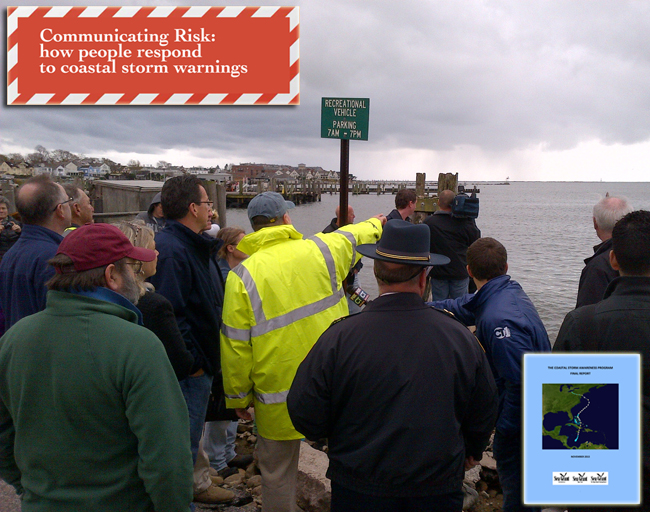
NOAA and Sea Grant researchers learned a lot from people who spoke up during our Coastal Storm Awareness Program surveys and meetings. Findings are summarized in a 23-minute short documentary and accompanying 4-and-a-half minute trailer, with content for both coming from The Coastal Storm Awareness Program's final report (pdf). This 286-page report details the NOAA-funded integrated program of Sea Grant research, communications and extension activities that was focused on improving the communication of and public response to coastal storm warnings in New Jersey, New York and Connecticut.
Investigators who spoke with people in the Sandy-affected region heard stories like the one about the disabled lady who evacuated to a shelter in her wheelchair-equipped van in the pouring rain, only to find the door at the end of the handicap ramp locked. We learned about individuals whose pets, family issues, and lack of transportation kept them from leaving when they should have. We learned that many coastal residents didn’t even know that they live in a flood zone, never mind where to go.
Photo: Connecticut Governor Malloy and others survey damage from Tropical Storm Irene in 2011. Credit: Office of Gov. Dannel P. Malloy.
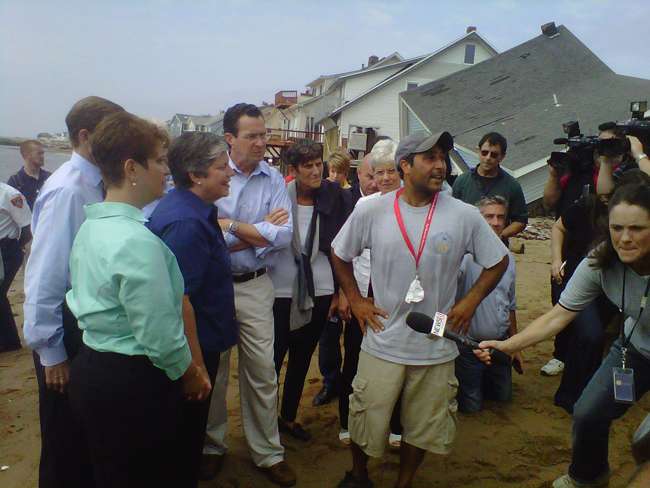
NOAA's Sea Grant programs in New Jersey, New York and Connecticut funded a suite of 10 social science studies under The Coastal Storm Awareness Program in an effort to better understand how people respond to coastal storm warnings. CSAP was first announced in October 2013 and the competitively-competed projects, which ran for a total of 18 months, were selected and announced by January 2014. Credit: Connecticut Sea Grant.
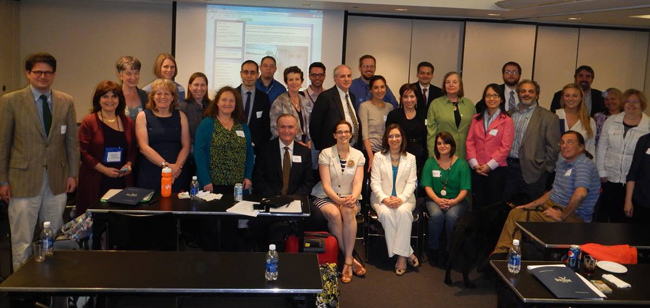
A Program Steering Committee was established that enabled both the CSAP researchers and Sea Grant staff to benefit from the expertise and feedback of individuals working for the NOAA National Weather Service, local and state emergency management, and environmental protection. Two “all hands” meetings (including May 2014's initial gathering in New York City, pictured here) were held, one to acquaint all of the principal investigators and foster potential inter-project collaborations and one to share and discuss the collective results.
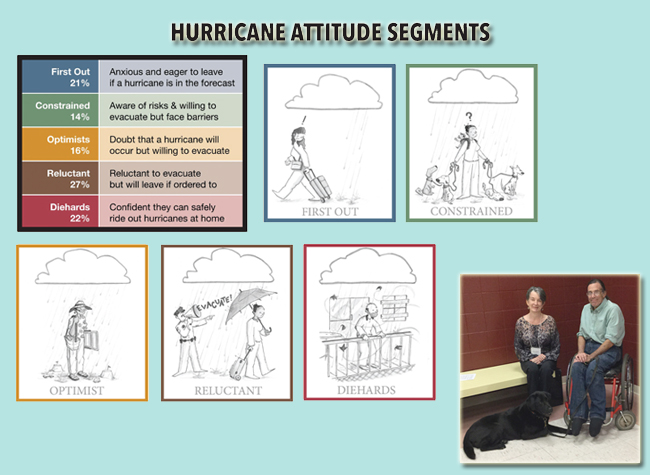
One strong message from Sharon Moran and William Peace’s SUNY ESF research project (pictured above, at bottom right) was that the rights of disabled persons and service animals need to be addressed in evacuation planning. Credit: Peg Van Patten/CTSG.
When it comes to facing severe coastal storms, there are a variety of roles that residents can play. Yale University's Jen Marlon (not pictured above) used a survey analysis to group respondents from the Connecticut coastal flood zone in five groups of attitudes and behaviors (which are depicted above). Diehards, for instance, will prepare to shelter in place, protect their property, and, hopefully, survive. Not everyone is a diehards when it comes to storms, though. Others face constraints that make it challenging for them to leave—they are caring for a loved one who is or they themselves are elderly/disabled or they have pets. Illustration Credit: ©Chris Cater / From J. Marlon et al., 2015, Yale University
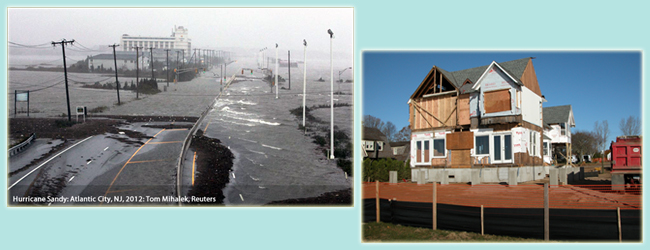
The New Jersey shore (pictured at left) suffered the most severe winds and surf from Hurricane Sandy and the most damage from the storm, estimated at 30 billion. This storm-damaged house in the Fenwick community of Old Saybrook CT (pictured at right) is being raised with a flow-through foundation for better storm resilience. Credit: Nancy Balcom/CTSG.
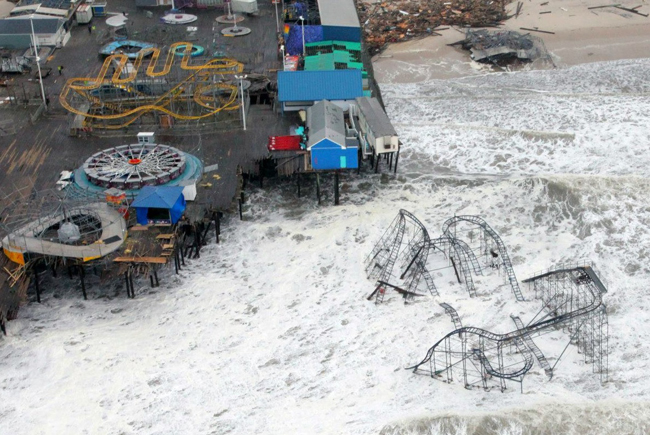
Aerial views of the damage caused by Hurricane Sandy to Casino Pier on the New Jersey coast, taken during a search and rescue mission by 1-150 Assault Helicopter Battalion, New Jersey Army National Guard, Oct. 30, 2012. Credit: U.S. Air Force, Master Sgt. Mark C. Olsen.
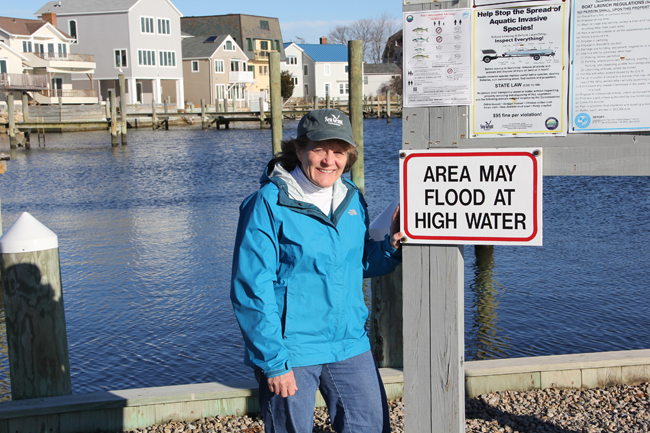
Connecticut Sea Grant's Associate Director Nancy Balcom stands by a flood zone warning sign near the University of Connecticut - Avery Point campus in Groton, where the NOAA coastal program is located. Credit: Peg Van Patten/CTSG.
More Info: New York Sea Grant
New York Sea Grant (NYSG), a cooperative program of Cornell University
and the State University of New York, is one of 33 university-based
programs under the National Sea Grant College Program (NSGCP) of the
National Oceanic and Atmospheric Administration (NOAA). The NSGCP
engages this network of the nation’s top universities in conducting
scientific research, education, training and extension projects designed
to foster science-based decisions about the use and conservation of our
aquatic resources. Through its statewide network of integrated
services, NYSG has been promoting coastal vitality, environmental
sustainability, and citizen awareness about the State’s marine and Great
Lakes resources since 1971.
New York Sea Grant maintains Great Lakes offices at SUNY Buffalo, the
Wayne County Cooperative Extension office in Newark and at SUNY Oswego.
In the State's marine waters, NYSG has offices at Stony Brook University
and Stony Brook Manhattan, in the Hudson Valley through Cooperative
Extension in Kingston and at Brooklyn College.
For updates on Sea Grant activities: www.nyseagrant.org has RSS, Facebook, Twitter, and YouTube links. NYSG also offers a free e-list sign up via www.nyseagrant.org/coastlines for its flagship publication, NY Coastlines/Currents, which is published several times a year.